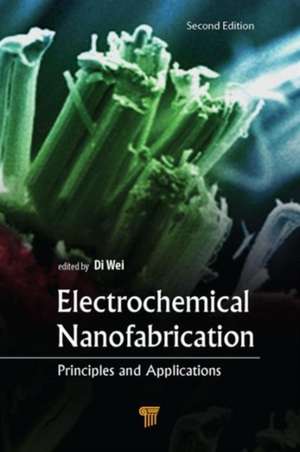Electrochemical Nanofabrication: Principles and Applications, Second Edition
Editat de Di Weien Limba Engleză Hardback – 9 iun 2016
With the development of nanotechnology and nanomaterials, the arena of electrochemical nanofabrication has expanded significantly. The first edition of this book was drafted in 2009. In 2010, the Nobel Prize in Physics was awarded to Prof. Konstantin Novoselov and Prof. Andre Geim from the University of Manchester for their groundbreaking experiments on the two-dimensional material graphene. Three years later, the European Commission launched the European Union’s biggest ever research initiative, the Graphene Flagship, with a budget of 1 billion euros. In light of these developments, this new edition of the book is enriched with the synthesis of graphene-based materials through electrochemical methods, the applications of graphene in lithium-ion and sodium-ion batteries, and the use of graphene composites in various sensing platforms. It will be of immense interest to a broad audience in nanotechnology and electrochemistry.
Preț: 636.55 lei
Preț vechi: 845.78 lei
-25% Nou
Puncte Express: 955
Preț estimativ în valută:
121.82€ • 132.28$ • 102.33£
121.82€ • 132.28$ • 102.33£
Comandă specială
Livrare economică 02-16 aprilie
Doresc să fiu notificat când acest titlu va fi disponibil:
Se trimite...
Preluare comenzi: 021 569.72.76
Specificații
ISBN-13: 9789814613866
ISBN-10: 981461386X
Pagini: 500
Ilustrații: 178
Dimensiuni: 152 x 229 mm
Greutate: 1.09 kg
Ediția:Revised
Editura: Jenny Stanford Publishing
Colecția Jenny Stanford Publishing
ISBN-10: 981461386X
Pagini: 500
Ilustrații: 178
Dimensiuni: 152 x 229 mm
Greutate: 1.09 kg
Ediția:Revised
Editura: Jenny Stanford Publishing
Colecția Jenny Stanford Publishing
Public țintă
Academic and PostgraduateCuprins
- Discusses the principles of electrochemical nanofabrication and their great potential in sensors, batteries, optoelectronics, and many future applications
- Presents contributions by leading scientists and researchers in the field
- Reviews the current state-of-the art and future prospects for electrochemical nanofabrication
Recenzii
"This book provides an innovative and thought-provoking view of electrochemical processes in nanofabrication. A comprehensive overview of the field is complemented by focused coverage of niche specialist topics involving metallic, oxide and polymeric materials in diverse combinations and complex interfacial architectures. A pedagogical approach to the central fundamental concepts allows the non-specialist to appreciate the significance of some perceptive subsequent analytical critique. Excellent use of illustrative material assists appreciation of the synergy between the novel fundamental science and its application in practical devices. This is an excellent book for those working in the field and others considering entering it."
--Prof. A. Robert Hillman, University of Leicester, UK
--Prof. A. Robert Hillman, University of Leicester, UK
Notă biografică
Di Wei is a senior member of Wolfson College at the University of Cambridge and senior researcher at Nokia Technologies. He was also nominated docent (adjunct professor) at Åbo Akademi University, Finland, in 2014. He has been Nokia’s principal investigator in energy work package within the European Union’s Graphene Flagship since 2013. His research covers organic electronics, sensors, and energy solutions (photovoltaics, supercapacitors, and batteries). In addition to contributing to over 50 peer-reviewed journal publications, 30 conference proceedings, 5 keynotes, and 50 international patents, Dr. Wei has written chapters for 4 books on the topics of nanotechnology and electrochemistry.
Descriere
Nanotechnology has attracted billions of dollars in venture capital from research institutes, governments, and industries in recent years. Traditional nanofabrication techniques have been intensively studied. However, the electrochemical nanofabrication technique, which offers huge benefits for manufacturing nanomaterials as well as broad applications in industries, has not been given much attention. This book summarizes various electrochemical nanofabrication methods and shows their various essential applications in areas such as batteries, sensors, and many future technologies.
